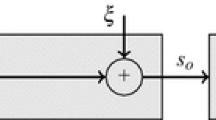Abstract
This paper deals with two-stage and multi-stage stochastic programs in which the right-hand sides of the constraints are Gaussian random variables. Such problems are of interest since the use of Gaussian estimators of random variables is widespread. We introduce algorithms to find upper bounds on the optimal value of two-stage and multi-stage stochastic (minimization) programs with Gaussian right-hand sides. The upper bounds are obtained by solving deterministic mathematical programming problems with dimensions that do not depend on the sample space size. The algorithm for the two-stage problem involves the solution of a deterministic linear program and a simple semidefinite program. The algorithm for the multi-stage problem invovles the solution of a quadratically constrained convex programming problem.
Similar content being viewed by others
References
E.M.L. Beale, “On minimizing a convex function subject to linear inequalities,”Journal of the Royal Statistical Society, Series B 17 (1955) 173–184.
E.M.L. Beale, G.B. Dantzig and R.D. Watson, “A first order approach to a class of multi-time-period stochastic programming problems,”Mathematical Programming Study 27 (1986) 103–117.
E.M.L. Beale, J.J.H. Forrest and C.J. Taylor. “Multi-time-period stochastic programming,” in: M. Dempster, ed.,Stochastic Programming (Academic Press, New York, 1980) pp. 387–402.
P. Billingsley,Probability and Measure (Wiley, New York, 1986).
J.R. Birge, “Decomposition and partitioning methods for multi-stage stochastic linear programs,”Operations Research 33 (1985) 989–1007.
J.R. Birge, “Aggregation bounds in stochastic linear programming,”Mathematical Programming 31 (1985) 25–41.
J.R. Birge and S.W. Wallace, “A separable precewise linear upper bound for stochastic linear programs,”SIAM Journal on Control and Optimization 26 (3) (1988) 725–739.
J.R. Birge and R.J.-B. Wets, “Designing approximation schemes for stochastic optimization problems, in particular for stochastic programs with recourse,”Mathematical Programming Study 27 (1986) 54–102.
G.R. Bitran and D. Sarkar, “On upper bounds of sequential stochastic production planning problems,”European Journal of Operational Research 34 (1988) 191–207.
G.R. Bitran and H.H. Yanasse, “Deterministic approximations to stochastic production problems,”Operations Research 32 (5) (1984) 999–1018.
G.B. Dantzig, “Linear programming under uncertainty,”Management Science 1 (1955) 197–206.
G.B. Dantzig,Linear Programming and Extensions (Princeton University Press, Princeton, NJ, 1963).
G.B. Dantzig and G. Infanger, “Multi-stage stochastic linear programs for portfolio optimization,” Technical Report SOL 91-11. Department of Operations Research, Stanford University, Stanford, CA. 1991.
R. Durret,Probability: Theory and Examples (Wadsworth, Pacific Grove, CA, 1991).
R. Entriken and G. Infanger, “Decomposition and importance sampling for stochastic linear models,”Energy, The International Journal 15 (7/8) (1990) 645–659.
S.J. Garstka and R.J.-B. Wets, “On decision rules in stochastic programming,”Mathematical Programming 7 (1974) 117–143.
H.I. Gassman, “MSLiP: A computer code for the multistage stochastic linear programming problem,”Mathematical Programming 47 (1990) 407–423.
J.L. Higle and S. Sen, “Stochastic decomposition: An algorithm for two-stage linear programs with recourse,”Mathematics of Operations Research 16 (1991) 650–669.
J. Higle, S. Sen and D.S. Yakowitz, “Finite master programs in stochastic decomposition,” Technical Report. Department of Systems and Industrial Engineering. The University of Arizona, Tucson, AZ. 1990.
J.K. Ho and E. Loute, “A set of staircase linear programming test problems,”Mathematical Programming 20 (1981) 245–250.
C. Huang, W. Ziemba and A. Ben-Tal, “Bounds on the expectation of a convex function of a random variable: With applications to stochastic programming,”Operations Research 25 (1977) 315–325.
G. Infanger, “Monte Carlo (importance) sampling within a Benders’ decomposition algorithm for stochastic linear programs, Extended version: Including results of large-scale problems,”Annals of Operations Research 39 (1991) 69–95.
G. Infanger,Planning under uncertainty: Solving large-scale stochastic linear programs (Boyd & Fraser, Danvers, MA, 1994).
I. Karatzas and S.E. Shreve,Brownian Motion and Stochastic Calculus (Springer-Verlag, New York, 1991).
F. Louveaux and N. Smeers, “Optimal investment for electricity generation A stochastic model and a test problem,” in: Y. Ermoliev and R.J.-B. Wets,Numerical Techniques for Stochastic Optimization (Springer-Verlag, Berlin, 1988).
A. Madansky, “Inequalities for stochastic linear programming problems,”Management Science 6 (2) (1960) 197–204.
H.M. Markowitz,Portfolio Selection: Efficient Diversification of Investments (Basil Blackwell, Cambridge, MA, 1991).
J.M. Mulvey and H. Vladimirou, “Stochastic network optimization models for investment planning,”Annals of Operations Research 20 (1989) 187–217.
R.T. Rockafellar and R.J.-B. Wets, “Scenarios and policy aggregation in optimization under uncertainty,”Mathematics of Operations Research 16 (1991) 119–147.
A. Ruszczynski, “Parallel decomposition of multistage stochastic programming problems,”Mathematical Programming 58 (1993) 201–228.
R.J. Vanderbei and B. Yang, “The simplest semidefinite programs are trivial,” Technical Report SOR-93-12, Program in Statistics and Operations Research, Princeton University, Princeton, NJ, 1993.
S.W. Wallace and T. Yan, “Bounding multi-stage stochastic programs from above,”Mathematical Programming 61 (1993) 111–129.
R.J.-B. Wets, “Stochastic programming,” in: G.L. Nemhauser, A.H.G. Rinnooy Kan and M.J. Todd eds.,Handbook in Operations Research and Management Science, Vol. 1 (Elsevier Science Publishers, Amsterdam, 1989) pp. 573–629.
S.E. Wright, “Primal-dual aggregation and disaggregation for stochastic linear programs,”Mathematics of Operations Research 19 (4) (1994) 893–908.
Author information
Authors and Affiliations
Rights and permissions
About this article
Cite this article
Schweitzer, E., Avriel, M. A gaussian upper bound for gaussian multi-stage stochastic linear programs. Mathematical Programming 77, 1–21 (1997). https://doi.org/10.1007/BF02614515
Received:
Revised:
Issue Date:
DOI: https://doi.org/10.1007/BF02614515



